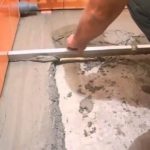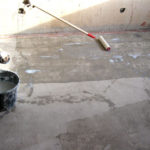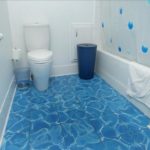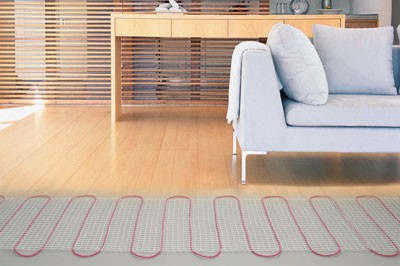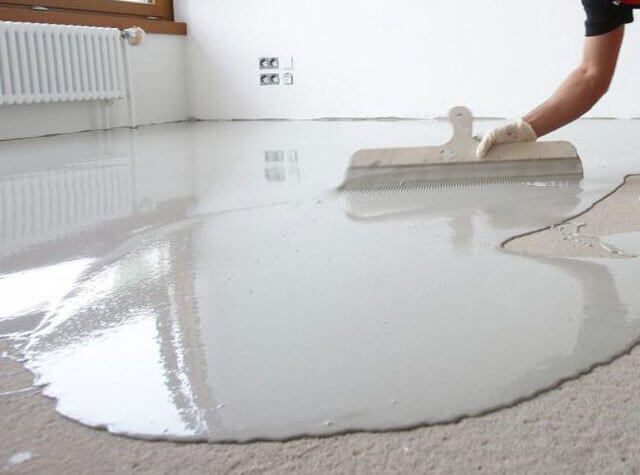Waterproofing a bathroom floor under tiles
The bathroom is a complex room from an engineering point of view. In conditions of a large number of plumbing fixtures and high humidity, it is impossible to do without protection. Insulation of the surface under the tiles should be planned at the stage of major renovation of the room. To carry out quality work, you must adhere to the rules and regulations.
The content of the article
What is floor waterproofing
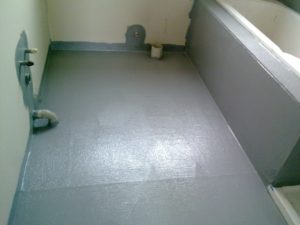 The bathroom floor consists of numerous layers that should be protected from destruction and fungus. For this purpose, waterproofing technology is used. The principle is to create a protective layer of materials with a special composition that protect against excess moisture. Due to the fact that the bathroom contains communications, it is necessary to properly create a sealed layer in all corners and joints.
The bathroom floor consists of numerous layers that should be protected from destruction and fungus. For this purpose, waterproofing technology is used. The principle is to create a protective layer of materials with a special composition that protect against excess moisture. Due to the fact that the bathroom contains communications, it is necessary to properly create a sealed layer in all corners and joints.
Reference. All materials are manufactured in accordance with accepted standards and regulations. High-quality products must meet safety requirements.
During a major overhaul, it is advisable to do complete waterproofing. If this is not possible, then a partial option will do. In this case, only the surface with high humidity needs to be treated.
Main areas:
- location of sewerage and pipelines;
- area under plumbing products;
- connection of pipes and other communications.
Types of waterproofing
There is a wide range of products for waterproofing floors. Each material differs in technical characteristics and installation method.
Main varieties:
- Coating type is a viscous substance that is applied to the surface. Due to the polymer content, after drying, a durable, damage-resistant and sealed surface is obtained. During production, bitumen is also used as the basis for the coating material. It is more affordable, but less durable.
- Roll waterproofing is a classic option. Modern roll material is made from improved bitumen. No special burners are required for installation. The composition also includes synthetic threads to increase strength and improve the elasticity of the material. When laid correctly, you will get a smooth and durable surface.
- Filled waterproofing option made from cement and polymer additives. The material hardens after drying, creating a dense protection. It is recommended to wait a day after pouring before starting to lay the tiles.
- Backfill type is a material made of expanded clay. Due to the high load on the floor, it can only be used in private properties and on the first floors of a high-rise building.
- Plaster mortar has a viscous structure with additives. Thanks to the special composition, the surface will have water-repellent properties. The insulator should be applied in several layers.
The type of waterproofing is selected depending on financial capabilities, type of floor and technical features of the bathroom.
Do-it-yourself waterproofing of the bathroom floor under tiles
Before starting work, it is necessary to clear the room of excess debris.The reliability of the surface depends on the quality of the preparatory stage.
Important. If there is a waterproofing layer on the floor, it must be removed. Applying the substance over an old surface will lead to a decrease in stability and tightness.
If there are chips and cracks on the floor, you need to cover them first. It is necessary to create a flat and smooth surface. If the height deviation exceeds 2 mm, problems will arise during the tile laying process. When the room is ready, you can begin the main stage. 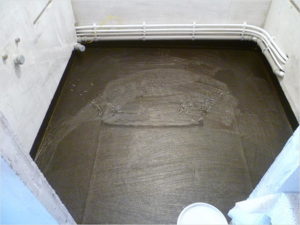
Step-by-step instruction:
- Before starting work, the joints along the entire perimeter are sealed with tape. They are necessary to strengthen and protect the screed from destruction. It is necessary to carefully lay the material and check the quality of the work.
- Depending on the type of waterproofing material, prepare the necessary tools. To apply the liquid solution you will need a roller, a brush and a suitable container. To avoid mixing the mixture by hand, a drill with an attachment will come in handy.
- If there are corners in the floor from pipes and sewers, then they should be processed. Tape is used around the perimeter to seal the joints. Thanks to the mesh structure, a durable and flexible material is obtained.
- Before applying the waterproofing material, the surface must be primed. The composition is applied evenly and in a thin layer. Next you should let it dry.
- Mix the composition immediately before application. Using a drill with a special attachment, the composition is prepared according to the instructions from the manufacturer. You need to use low speeds. Larger ones may cause bubbles to form.
Attention. When stirring, you should strictly observe all proportions and adhere to the manufacturing technique.
- The next step is coating.To do this you will need a spatula or a stiff brush. The composition should be carefully and evenly applied to the entire surface of the floor. It is also necessary to coat 5-10 cm of the wall around the perimeter for additional protection.
- After applying the first layer, it must be allowed to dry. Depending on the composition, complete drying time varies between 10–12 hours. The second layer is laid in the same way. It is necessary to create a smooth surface without chips or dents. If necessary, apply more composition.
When choosing roll waterproofing, the surface does not need to dry after installation. You can start laying tiles right away. The coating and pouring type requires drying up to 24 hours.
Pros and cons of waterproofing
There is always excess moisture in the bathroom. Therefore, materials should be protected and destruction prevented. The use of waterproofing technology during repairs has a number of advantages.
The advantages of this method:
- High tightness of the floor surface is ensured by the polymer substances included in the composition.
- Waterproofing can protect tiles from the appearance of fungus in hard-to-reach places.
- Additional leveling of the floor occurs due to viscous materials. In this case, the tile will be more securely fixed.
- Increasing the service life of plumbing equipment and pipe communications.
- Simplicity in installation technology and a large selection of materials for surface treatment.
Among the many advantages, there are minor disadvantages. Installation of waterproofing will require additional costs for the purchase of materials, and will also increase the completion time of repairs by several days. Applying insulation under the tiles is a simple process, but if you wish, you can contact a professional team.
When renovating a bathroom, you should carefully insulate the floor underneath the tiles. Excess moisture can destroy the coating and lead to the formation of mold. Modern materials consist of safe and damage-resistant substances. You can carry out the installation and application of the waterproofing layer yourself. It is required to follow the basic rules and not disrupt the technological process. The result is a durable piece of work.

